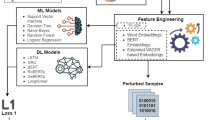Abstract
Nowadays, social media has become the leading platform for news dissemination and consumption. Due to the convenience of social media platforms, fake news spread at an unprecedented speed, which has brought severe adverse effects to society. In recent years, the method based on deep learning has shown superior performance in fake news detection. However, the training of this kind of model needs a large amount of labeled data. When a new domain of fake news appears, it usually contains only a small amount of labeled data. We proposed a novel Domain Adaptation framework for Fake news Detection named DAFD. It adopts a dual strategy based on domain adaptation and adversarial training, aligns the data distribution of the source domain and target domain during the pre-training process, and generates adversarial examples in the embedding space during the fine-tuning process to increase the generalization and robustness of the model, which can effectively detect fake news in a new domain. Extensive experiments on real datasets show that the proposed DAFD achieves the best performance compared with the state-of-the-art methods for a new domain with a small amount of labeled data.
Access this chapter
Tax calculation will be finalised at checkout
Purchases are for personal use only
Similar content being viewed by others
References
Borgwardt, K.M., Gretton, A., Rasch, M.J., Kriegel, H.P., Schlkopf, B., Smola, J.A.: Integrating structured biological data by kernel maximum mean discrepancy. Bioinformatics 22, e49–e57 (2006)
Cheng, Y., Jiang, L., Macherey, W.: Robust neural machine translation with doubly adversarial inputs (2019). arXiv preprint arXiv:1906.02443
Davis, J., Domingos, P.: Deep transfer via second-order markov logic. ACM (2009)
Devlin, J., Chang, M.W., Lee, K., Toutanova, K.: Bert: pre-training of deep bidirectional transformers for language understanding (2018). arXiv preprint arXiv:1810.04805
Howard, J., Ruder, S.: Universal language model fine-tuning for text classification (2018). arXiv preprint arXiv:1801.06146
Kim, Y.: Convolutional neural networks for sentence classification. Eprint Arxiv (2014)
Lan, Z., Chen, M., Goodman, S., Gimpel, K., Sharma, P., Soricut, R.: Albert: a lite bert for self-supervised learning of language representations (2019). arXiv preprint arXiv:1909.11942
Ma, J., Gao, W., Wei, Z., Lu, Y., Wong, K.F.: Detect rumors using time series of social context information on microblogging websites. In: Proceedings of the 24th ACM International on Conference on Information and Knowledge Management, pp. 1751–1754 (2015)
Van der Maaten, L., Hinton, G.: Visualizing data using t-sne. J. Mach. Learn. Res. 9(11), 2579–2605 (2008)
Madry, A., Makelov, A., Schmidt, L., Tsipras, D., Vladu, A.: Towards deep learning models resistant to adversarial attacks (2017). arXiv preprint arXiv:1706.06083
Miyato, T., Dai, A.M., Goodfellow, I.: Adversarial training methods for semi-supervised text classification (2016). arXiv preprint arXiv:1605.07725
Patwa, P., et al.: Fighting an infodemic: Covid-19 fake news dataset (2020). arXiv preprint arXiv:2011.03327
Qian, F., Gong, C., Sharma, K., Liu, Y.: Neural user response generator: fake news detection with collective user intelligence. In: IJCAI, vol. 18, pp. 3834–3840 (2018)
Ruchansky, N., Seo, S., Liu, Y.: Csi: a hybrid deep model for fake news detection. In: Proceedings of the 2017 ACM on Conference on Information and Knowledge Management, pp. 797–806 (2017)
Shu, K., Cui, L., Wang, S., Lee, D., Liu, H.: Defend: explainable fake news detection. In: Proceedings of the 25th ACM SIGKDD International Conference on Knowledge Discovery & Data Mining, pp. 395–405 (2019)
Shu, K., Mahudeswaran, D., Wang, S., Lee, D., Liu, H.: Fakenewsnet: a data repository with news content, social context, and spatiotemporal information for studying fake news on social media. Big Data 8(3), 171–188 (2020)
Tacchini, E., Ballarin, G., Della Vedova, M.L., Moret, S., de Alfaro, L.: Some like it hoax: automated fake news detection in social networks (2017). arXiv preprint arXiv:1704.07506
Tzeng, E., Hoffman, J., Zhang, N., Saenko, K., Darrell, T.: Deep domain confusion: Maximizing for domain invariance. Comput. Sci. (2014)
Yang, Z., Yang, D., Dyer, C., He, X., Smola, A., Hovy, E.: Hierarchical attention networks for document classification. In: Proceedings of the 2016 Conference of the North American Chapter of the Association for Computational Linguistics: Human Language Technologies, pp. 1480–1489 (2016)
Yosinski, J., Clune, J., Bengio, Y., Lipson, H.: How Transferable are Features in Deep Neural Networks? MIT Press, Cambridge (2014)
Zhang, J., Li, W., Ogunbona, P.: Joint geometrical and statistical alignment for visual domain adaptation. In: Proceedings of the IEEE Conference on Computer Vision and Pattern Recognition, pp. 1859–1867 (2017)
Zhu, C., Cheng, Y., Gan, Z., Sun, S., Goldstein, T., Liu, J.: Freelb: enhanced adversarial training for language understanding (2019)
Acknowledgments
Yinqiu Huang, Min Gao, and Jia Wang are supported by the Natural Science Foundation of Chongqing (cstc2020jcyj-msxmX0690). Kai Shu is supported by the John S. and James L. Knight Foundation through a grant to the Institute for Data, Democracy & Politics at The George Washington University.
Author information
Authors and Affiliations
Corresponding author
Editor information
Editors and Affiliations
Rights and permissions
Copyright information
© 2021 Springer Nature Switzerland AG
About this paper
Cite this paper
Huang, Y., Gao, M., Wang, J., Shu, K. (2021). DAFD: Domain Adaptation Framework for Fake News Detection. In: Mantoro, T., Lee, M., Ayu, M.A., Wong, K.W., Hidayanto, A.N. (eds) Neural Information Processing. ICONIP 2021. Lecture Notes in Computer Science(), vol 13108. Springer, Cham. https://doi.org/10.1007/978-3-030-92185-9_25
Download citation
DOI: https://doi.org/10.1007/978-3-030-92185-9_25
Published:
Publisher Name: Springer, Cham
Print ISBN: 978-3-030-92184-2
Online ISBN: 978-3-030-92185-9
eBook Packages: Computer ScienceComputer Science (R0)




